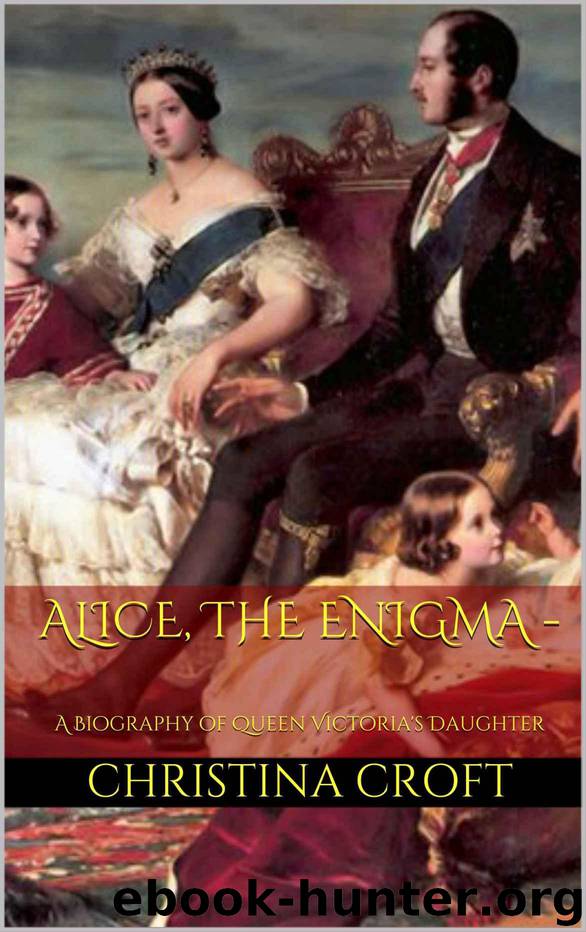Alice, The Enigma - A Biography of Queen Victoria's Daughter by Croft Christina

Author:Croft, Christina [Croft, Christina]
Language: eng
Format: azw3, epub, mobi
Publisher: Hilliard & Croft
Published: 2013-11-23T16:00:00+00:00
Chapter 12 –
Strength of Mind & Self-Sacrifice
Paralysed by shock and bewilderment, Queen Victoria withdrew from the world, refusing to see anyone but Alice and the Duchess of Kent’s former lady-in-waiting, Lady Augusta Bruce. Numb with grief, she was unable to weep, but then, when her tears burst forth, members of the household claimed they heard her desperate wailing echoing along the corridors of Windsor Castle. Alternatively deifying Prince Albert and lamenting the ‘lack of pluck’ which led to his demise, she insisted that his shaving water should be changed each morning, and his nightshirt laid out for him each night – it was a practice which would continue for the next forty years.
Black crepe draped every corridor and every item of furniture at Windsor; preparations for Christmas were abandoned, and the Queen discarded the bright colours of the past to don the widow’s weeds that she would wear to the end of her life. In the country at large there was a sense of shock and sorrow, too, as people mourned not so much for the death of a foreign prince but for the sorrow of his forty-two-year-old widow and her fatherless children.
It has often been implied that during the early days of her bereavement the Queen was on the verge of insanity. From a modern viewpoint her excessive grief might suggest that that was indeed the case but a glance at the evidence shows that this was far from the truth. In the 19th century, death was treated very differently from how it is dealt with today. Black plumed horses bearing coffins draped in black palls were a common sight, and outlandish statues and headstones cluttered the churchyards. Victorian literature was filled with dramatic death scenes, which the people of the time relished but which now appear overly sentimental – one need only think of the public outpouring of grief at the death of Little Nell in the serialisation of Dickens’ The Old Curiosity Shop, or the death of Beth in Louisa May Alcott’s Little Women. In the average middle-class home, gloomy paintings and embroidered inscriptions about the briefness of life hung on the walls; and even the most popular songs of the time wallowed in mawkish morbidity: ‘Father’s a Drunkard and Mother is Dead’, and ‘The Vacant Chair’ to name but two. Rather than being viewed as macabre, dramatic demonstrations of grief were seen as signs of respect for the departed and as evidence of the depths of love they had inspired in the bereaved.
In all aspects of life, Queen Victoria was a passionate woman, and one, incidentally, who was very fond of popular novels, so it is unsurprising that her reaction to the death of Prince Albert appears melodramatic. There is also the possibility that the witnesses who wrote of her ‘wailing’ at Windsor, were simply following the tradition of writers of the day to demonstrate the extent of her grief. The fact that she snatched the sleeping Beatrice from her cot is often cited as an
Download
Alice, The Enigma - A Biography of Queen Victoria's Daughter by Croft Christina.epub
Alice, The Enigma - A Biography of Queen Victoria's Daughter by Croft Christina.mobi
This site does not store any files on its server. We only index and link to content provided by other sites. Please contact the content providers to delete copyright contents if any and email us, we'll remove relevant links or contents immediately.
| France | Germany |
| Great Britain | Greece |
| Italy | Rome |
| Russia | Spain & Portugal |
Fanny Burney by Claire Harman(26528)
Empire of the Sikhs by Patwant Singh(22977)
Out of India by Michael Foss(16792)
Leonardo da Vinci by Walter Isaacson(13189)
Small Great Things by Jodi Picoult(7024)
The Six Wives Of Henry VIII (WOMEN IN HISTORY) by Fraser Antonia(5397)
The Wind in My Hair by Masih Alinejad(5034)
A Higher Loyalty: Truth, Lies, and Leadership by James Comey(4846)
The Lonely City by Olivia Laing(4751)
The Crown by Robert Lacey(4727)
Millionaire: The Philanderer, Gambler, and Duelist Who Invented Modern Finance by Janet Gleeson(4382)
The Iron Duke by The Iron Duke(4293)
Papillon (English) by Henri Charrière(4199)
Sticky Fingers by Joe Hagan(4103)
Joan of Arc by Mary Gordon(4016)
Alive: The Story of the Andes Survivors by Piers Paul Read(3970)
Stalin by Stephen Kotkin(3879)
Aleister Crowley: The Biography by Tobias Churton(3589)
Ants Among Elephants by Sujatha Gidla(3417)
